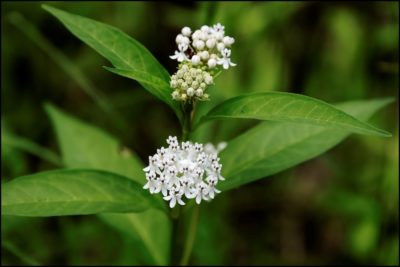
Aquatic milkweed (Asclepias perennis) by Wade Collier
- Milkweeds are named for their milky latex, which is found in their stems, leaves, and pods and make them unpalatable to many animals.
- Milkweeds produce high quality nectar and depend on a variety of insects (bees, wasps, butterflies, moths, flies, beetles, and true bugs) to transfer pollen for seed production. Although adult monarchs visit milkweeds for nectar, swallowtail butterflies and Nymphalis species are more frequent visitors.
- The red milkweed beetle (Tetraopes tetrophthalmus) is another insect that uses the milkweed plant and its poisonous sap as a defense. It even shares a similar color scheme as the Monarch butterfly to advertise its toxicity!
- Milkweed pollen is similar to that of orchids, which is carried in special sacks called pollinia that are located in vertical grooves in the flowers.
- Milkweed has ethnobotanical history dating back to native American populations. Cloth and rope were woven from fibers and stems, plant sap was used to cure ringworm and bee stings, and roots were made into a drink to treat venereal disease or coughs. Butterfly milkweed is sometimes called “pleurisy root” and sold as herbal medicine today.
- In the 1940s, milkweed seed fibers were used to fill life preservers. Today, they continue to be used as hypoallergenic filling in blankets and pillows. During the 1970s and 80s, milkweed was tested as a biofuel resource, which was later destined to be uneconomical, just like their possibility of being a substitute for crude petroleum and natural rubber. Milkweed chemicals have even been evaluated as a treatment for breast cancer.
- Check out this fact sheet from Monarch Joint Venture
Learn how to get involved in the May “Monarchs and Milkweed” challenge HERE.
